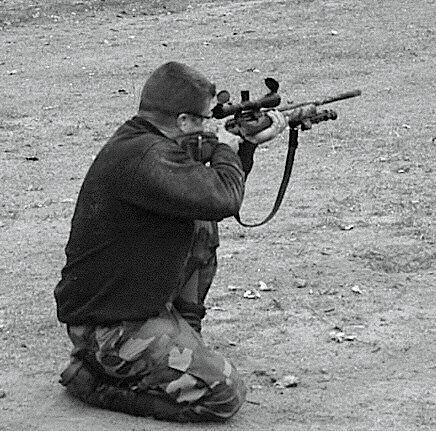
Editor’s Note: This feature is from our companion service, The Tactical Wire – the 10th Anniversary of which we’ll celebrate next week.
“In the days of my youth, the subject of rifle marksmanship was approached step-by-step. The first was sighting and aiming. The second was the firing position. The third was trigger control. And the fourth was rapid fire.”
Jeff Cooper, The Art Of The Rifle
When I learned to fire a rifle, a .22 bolt action, this is exactly the sequence my father and grandfather used to teach me. It makes perfect sense. You have to know how to use the sights in order to place your hits in their intended location. The various firing positions, especially prone, provide stability, allowing the shooter to focus on the sighting and trigger control. Finally you move into rapid fire, but only shooting as fast as you can hit. Today it seems most shooters never, or very rarely work with traditional firing positions such as prone, kneeling and sitting. From one hundred yards have them hit prone, which should create more stability and accuracy, and the average results are usually disappointing.
There are two maxims for rifle shooting. First, if you can get closer, get closer. Obviously common sense applies here; for example it may not be a good ideal to approach a threat. Second, if you can get steadier then get steadier. This may sound like common sense, but you’ll see a lot of shooters get so excited and wrapped up in making the shot that they fire from standing, and miss, as opposed to getting into kneeling for more stability and accuracy. You create stability by lowering your center of gravity and/or creating more contact points between your body and something solid.
A crucial part of your rifle training and practice should include traditional firing positions. Learn the differences, and what works best for you, between the “American Military” prone and “Olympic” prone. When it comes to sitting you have crossed leg, crossed ankle and open leg. Braced kneeling, where the support side elbow is braced on the support side knee, is a mandatory field position. Even when standing there is a difference between a traditional “standing” position and the “offhand” stance.
Use of the sling is another traditional skill that has fallen by the side. You can use the “hasty” sling method with a standard type two-point sling, loop up into a leather-shooting type sling, or there’s my favorite, the Ching sling, which is easy and quick to use. Whenever the weak side elbow is supported, for example on in braced kneeling or prone on the ground, using the sling provides stability and accuracy.
Learning the traditional firing positions allows you to modify them for field use as dictated by the environment. Use a good position and modify it as necessary, like bracing or resting on objects in the environment. Then, sometimes you have to fire at longer distances from standing or offhand. Just keep in mind when you give up something or compromise in one area, like stability, then you compensate for it in another area, like ensuring a smooth trigger press. Rifle marksmanship, according to Cooper, “is dependent entirely upon individual self-control, and self-control is out of fashion in the Age of the Common Man.” Training and practice create confidence. You “know” you can make the shot. Confidence leads to self-control, the secret to success in any conflict.
Tiger McKee is director of Shootrite Firearms Academy, located in northern Alabama. He is the author of “The Book of Two Guns” - http://shootrite.org/book/book.html writes for several firearms/tactical publications, and is featured on GunTalk’s DVD, “Fighting With The 1911 - http://shootrite.org/dvd/dvd.html McKee’s new book, AR-15 Skills and Drills, is available off Shootrite’s website
http://www.facebook.com/pages/Shootrite-Firearms-Academy/156608611038230?ref=ts